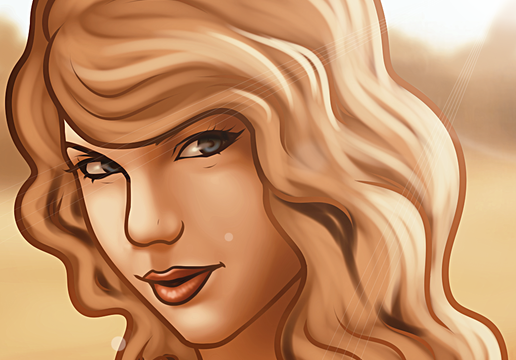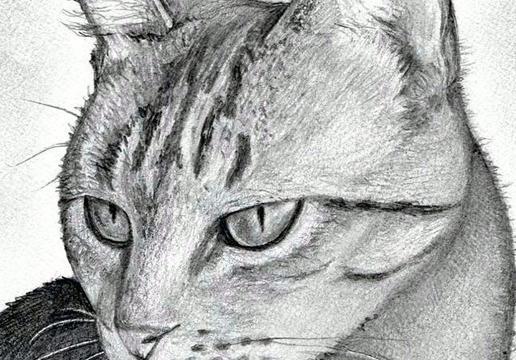Matt Damon Drawing Lesson
1
Sketch in the oval and strange crescent shape on top as just a reminder that his hair will be there. Also sketch in bisecting line down the middle of the oval.
2
Draw in parallel lines in the next picture very lightly (if you want with a straight edge). These are to help with eyebrows, eyes, nose and mouth placement.
3
For more accuracy, put your picture to the mirror. Also take your reference pic and put it there too! You'll see clearly differences between the two. To measure out where the features go, take an envelope, piece of paper or a ruler (straight edge)...
4
Erase all the guidelines and other distracting lines. Your picture won't look exactly like this, but remember my picture is only a guide... that's it. Now we are going to start with shading.
5
Start shading with a pencil, even a No. 2 pencil will do well. Shade diagonally around the eyes. Also fill in the pupils, leaving some catchlights. Stroke the eyebrows in, giving a hairy appearance.
6
Continue to shade in the white of his eyes below the guidelines. Shade more at the corner of his eyes. Do this lightly. Also sketch in the side of his forehead, and underneath his eyes. I have not blended yet. I'm just adding more lines and make sure
7
Now let's add more detail to the nose. Those pyramid type of lines help to place the shading. The tip of the nose is darkened for definition. Can you see how the basic shape of the nose is triangular? Hopefully, this will make it easier to draw.
8
Go ahead and lightly shade with diagonal strokes. Now using a .7mm HB or even 2B lead in the mechanical pencil is great. It doesn't wear down, you don't have to sharpen it, and it's quality remains the same.
9
Here we are starting with the mouth. The basic image is there and tweaking, erasing hasn't happened yet. Just shade lightly at a diagonal slant.
10
Branch out to shade his cheek lines and lower part of lip. Look at my picture as a reference to see where the lower lines of the lip takes form. Also shading has started on his chin and neck.
11
Add curls and line strokes to his hair. Notice how everything starts out real simple then I build up on the picture. Always look at the reference, draw from it, and observe the placement of your shapes.
12
When you follow the arrows as you fill in this hair example, it adds realism. Hair strands start at the root and then flow out. That's what you the artist is mimicking. The hair shouldn't appear flat. TIP: When you start a stroke with your pencil, th
13
Keep adding those hair strokes in the direction of the curls. It helps to keep looking at the reference and not assuming where the lines flow.
14
Keep stroking his hair, leaving white areas like in this picture. This technique ensures highlights in his hair. Make sure your pencil is sharp and start shading his jacket.
15
Continue to add more hair strokes. Sketch lightly over his face with your No.2 pencil. Do diagonal strokes or small circles. This technique adds tone to his skin. Shade his jacket and shirt.
16
Add darker shading with your pencil. It is not how hard you press your pencil, but by the multiple layers you darken your picture with. You can press a little harder with your No. 2 pencil, but not to the point of creasing your paper. The dark parts
17
The blending stump can work miracles for your picture. Use the skinny, tiny one for small areas, like around the eyes, in the nose and mouth. The larger stump can blend larger areas, even the cheek areas and skin tone area. Now if you want a really s
18
"Tools Of The Trade" I absolutely love giving tools and tips. In Step 9 picture. Let me introduce you to the ELECTRIC PENCIL SHARPENER. It'll save you plenty of time. Also I've used an interchangeable mechanical pencil size 0.7. The lead sizes used a
19
The picture that goes with this step shows two different ways to hold your pencil to acquire certain effects. OVERHAND: Holding a sharpened pencil in normal writing form with fingers in the middle or near the lead gives you great control and thin/det
20
You can use your rubber kneaded eraser for reflective lights, white hair strands, or highlights on the nose or in the pupil. Remember that the reflective light area isn't pure white--it is at middle tone. Your blending tools add a smoother tone to yo
21
It does take time and patience to do a full-blown pencil portrait like this. Since the blending lightened areas of the drawing, you need to darken the shading like his hair, sideburns, side of face, neck, shirt and jacket. Add more lines to his lower
22
Add the background only. Get as close to the hair as you can with the 9B graphite crayon, which does wonder in adding that darkened look. Leave a small white space when cover. Then you can fill that out with a 9B graphite pencil (which has a sharper
Comments 0
Details
September 2, 2015
Description: Hi! I'm b-a-a-a-c-k! This time it's Matt Damon, a very renown actor, screenwriter, and producer. You might know him from movies like The Rainmaker (which I loved), Bourne Identity series (I was totally thrilled with those), and Good Will Hunting (I loved) where he and Ben Afflect did the screenplay for this movie and won an Oscar! Amazing, right? He's starred in many other great movies. Well, I enjoyed his acting sooo much. I have the great pleasure of doing this tutorial of him. I just hope I don't disappoint. I look forward to your Fav, Comment or Like.















































